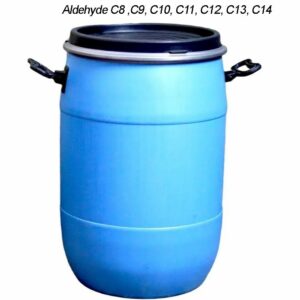Aldehyde C8, C9, C10, C11, C12, C13, C14 Product Descriptions and Uses
Aldehydes are organic compounds characterized by the presence of a carbonyl group (C=O) bonded to a hydrogen atom. They are widely used in various industries, including fragrance, flavoring, and chemical synthesis. Below is a detailed description of aldehydes C8 to C14, including their uses and technical data.
Product Descriptions
-
Aldehyde C8 (Caprylic Aldehyde)
- Description: A colorless liquid with a strong, fatty odor.
- Uses: Commonly used in the fragrance industry to impart a fresh, marine scent. It is also used in flavoring and as an intermediate in chemical synthesis.
-
Aldehyde C9 (Nonanal)
- Description: A clear, colorless liquid with a pleasant, citrus-like odor.
- Uses: Utilized in perfumes and as a flavoring agent. It is also used in the production of surfactants and other chemical intermediates.
-
Aldehyde C10 (Decanal)
- Description: A colorless liquid with a waxy, citrus aroma.
- Uses: Primarily used in the fragrance industry for its pleasant scent. It is also used in the synthesis of various chemical compounds.
-
Aldehyde C11 (Undecanal)
- Description: A colorless liquid with a fatty, waxy odor.
- Uses: Employed in the production of fragrances and flavors, as well as in the synthesis of other organic compounds.
-
Aldehyde C12 (Dodecanal)
- Description: A colorless to pale yellow liquid with a strong, fatty odor.
- Uses: Used in the fragrance industry and as a flavoring agent. It also serves as a precursor for various chemical syntheses.
-
Aldehyde C13 (Tridecanal)
- Description: A colorless liquid with a mild, fatty odor.
- Uses: Primarily used in the fragrance industry and as a chemical intermediate.
-
Aldehyde C14 (Tetradecanal)
- Description: A colorless liquid with a strong, fatty aroma.
- Uses: Used in perfumes and as a flavoring agent, as well as in the synthesis of other chemical compounds.
Technical Data Table
| Aldehyde | Chemical Formula | Molecular Weight (g/mol) | Boiling Point (°C) | Flash Point (°C) | Density (g/cm³) | Odor Description |
|---|---|---|---|---|---|---|
| C8 | C8H16O | 128.21 | 165-166 | 60 | 0.83 | Fatty, marine |
| C9 | C9H18O | 142.24 | 196-197 | 70 | 0.83 | Citrus-like |
| C10 | C10H20O | 156.26 | 210-211 | 80 | 0.83 | Waxy, citrus |
| C11 | C11H22O | 170.29 | 220-221 | 85 | 0.83 | Fatty, waxy |
| C12 | C12H24O | 184.31 | 230-231 | 90 | 0.83 | Strong, fatty |
| C13 | C13H26O | 198.34 | 240-241 | 95 | 0.83 | Mild, fatty |
| C14 | C14H28O | 212.36 | 250-251 | 100 | 0.83 | Strong, fatty |
Summary
Aldehydes C8 to C14 are versatile compounds with significant applications in the fragrance and flavor industries. Their unique properties and pleasant aromas make them valuable in creating various products, from perfumes to food flavorings. Understanding their technical data helps in selecting the appropriate aldehyde for specific applications.

